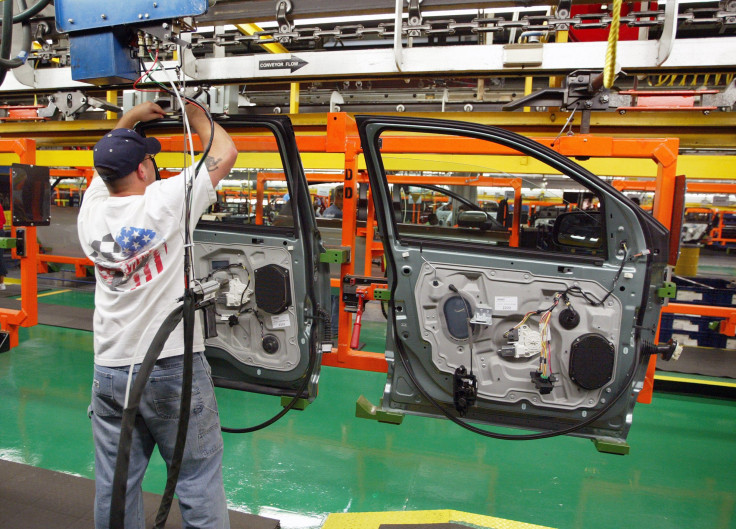Hopes Of Factory Jobs Rebound Fade In US Heartland

The U.S. factory sector appears to be stabilizing after a long and painful slide, but not when it comes to jobs.
You might not hear that from Washington, where the latest job report for April showed factories added 4,000 positions and other measures suggest the sector has stopped contracting. That comes after a three month stretch of job cuts — including March, the worst single month for job losses since the recession — that wiped out all of last year’s modest gains.
Manufacturing's job problem undercuts hopeful forecasts that U.S. companies would bring significant numbers of jobs back from overseas. That's simply not happening to a degree sufficient to offset the continuing exodus of work and suggest deeper problems roiling factory floors.
The fallout is most visible on the U.S. campaign trail, where Donald Trump has ridden the wave of anger about losing jobs to become the presumptive nominee for Republican party. But interviews with more than a dozen company executives and analysts across the U.S. heartland show the plight of manufacturing is more than a campaign slogan.
"People are hanging on by their fingernails in manufacturing," said J.B. Brown, president of Bremen Castings Inc. in Indiana, which saw business for its metal casting drop off sharply last year and is now down 40 percent from 2014.
The slowdown in oil and gas has radiated deep into the economy and huge cuts by heavy equipment and farm machinery manufacturers are battering thousands of smaller suppliers across the industrial belt. Caterpillar Inc. (CAT.N) alone is in the midst of shuttering 20 facilities, about half of them in the U.S., and has permanently shed 3,500 U.S. workers through restructurings.
Christopher Williamson, chief economist at Markit, told Reuters the job cuts are driven by a mix of “disappointing order books” and a cloudier political outlook.
"Companies are becoming more reluctant to expand and more cost conscious, so that cutback in hiring is a reflection of that," said Williamson. By his estimate, U.S. factories are now cutting an average of 10,000 jobs a month, and he sees that continuing.
It’s not a rout across the board for U.S. factories. The auto industry continues to hum, thanks to the relatively robust consumer economy. Housing is also thriving.
"Basically we’ve just had the best quarter we’ve had in 10 years," says James Metcalf, chief executive of USG Corp. (USG.N), a maker of wallboard used in construction that had sales of $3.8 billion last year. At the same time, some of the stiffest headwinds for manufacturing have abated. Oil prices are edging back up and the dollar, which has hampered exports, has weakened a bit.
Gloom Spreads Across Rust And Farm Belt
Even so, the downturn has spread gloom across the U.S. industrial heartland, visible in the political backlash against trade in the presidential campaign. A video of workers at a Carrier air-conditioner plant in Indiana being told their jobs were moving to Mexico went viral last fall and became a favorite topic for Trump on the campaign trail.
Job cuts in manufacturing only add to the dissatisfaction of voters in industrial regions who worry that the growing economy is passing them by.
People living in the Rust Belt, which includes Illinois, Indiana, Michigan, Missouri, Pennsylvania and Ohio, are more pessimistic about the direction of their state than their counterparts in other parts of the country.
According to a Reuters/Ipsos poll from March 1 to April 30, 60 percent of Rust Belt residents said their state is headed on the “wrong track,” compared with 49 percent of residents in other states. The results include 1,922 Rust Belt residents and have a credibility interval of 2.6 percentage points. For a graphic showing this dire view, see:tmsnrt.rs/1T6Z7Rn
The weak job numbers don’t surprise William Bachman, president of Bachman Machine Co. in St. Louis, which has 105 employees makes metal parts that go into the automotive, agriculture, and industrial equipment. “I just found out that one of my customers had more exposure to oil field machinery than I realized,” he says. Another big customer was hit by the drop in demand for farm machinery.
"In my little world, I just keep hearing about things slowing down," said Bachman, who has shed only a few workers so far and opted not to replace some workers who retired.
Government gauges haven’t captured the full depth of the manufacturing slowdown until recently. Last month, as part of its regular update of economic figures, the Federal Reserve cut by half the growth in manufacturing output for the last two years. That's a huge reduction and shows that growth was far weaker than most analysts thought. Before the revision, the sector had appeared close to regaining its pre-recession peak in output.
That goal has now again been pushed out far into the future.
"The real question is how can you have any job growth when overall growth is so slow?" says Daniel Meckstroth, chief economist of the Manufacturers Alliance for Productivity and Innovation.
Some economists are more upbeat, noting that there are signs the long slide has at least stabilized. The Institute for Supply Management has issued two straight monthly reports that showed U.S. manufacturing activity expanded slightly, ending a five-month string of reports that suggested contraction. April’s ISM report showed 11 out of 18 industries reported growth.
And yet many Midwest manufacturers say they are as disillusioned with Washington's view of the economy as their hourly workers. Scott Wine, CEO of snowmobile maker Polaris Industries Inc. in Minnesota, says the U.S. Federal Reserve has sown uncertainty with shifting views on when to raise interest rates.
"First they say the economy's strong, so we'll raise rates," said Wine. "Then they say it's weak, so we won't. So of course, producers are worried."
© Copyright Thomson Reuters 2024. All rights reserved.



















